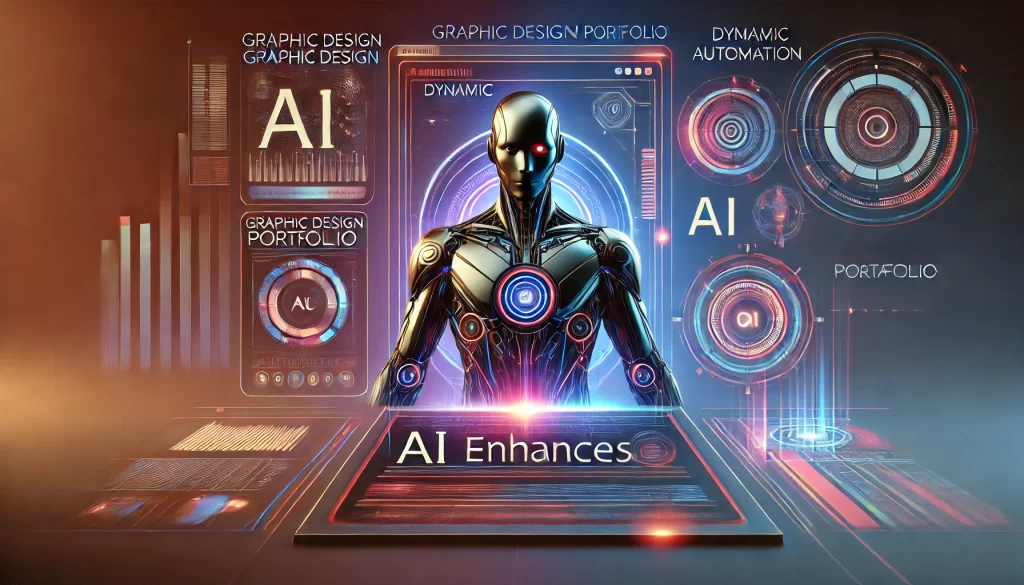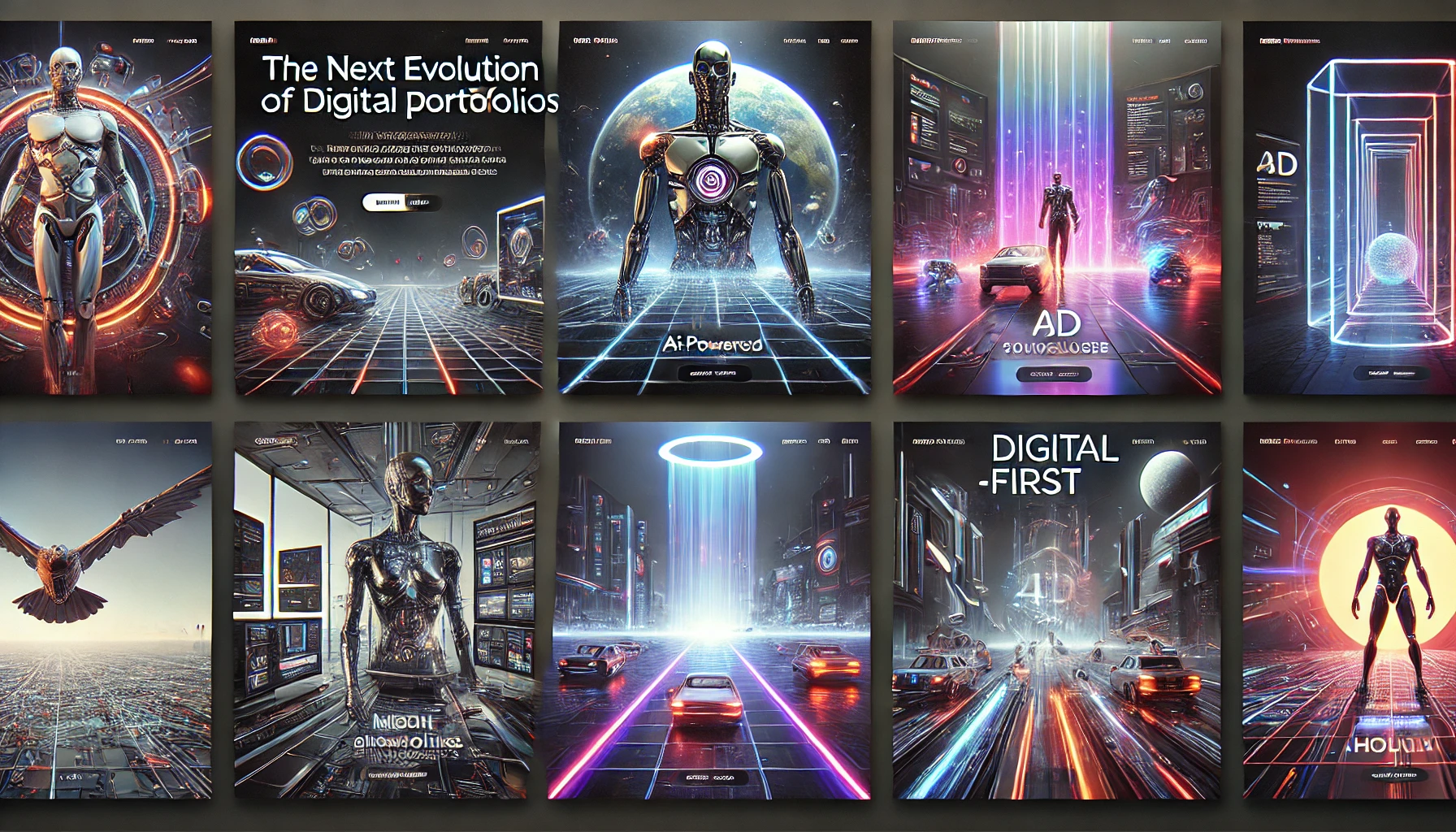The Portfolio Has Evolved. Have You?
Ten years ago, a clean grid and high-res thumbnails were enough. You launched your portfolio, added a contact form, and hoped someone would reach out.
Today? That doesn’t cut it.
Modern design portfolios are no longer just digital galleries, they’re immersive experiences, strategic conversion tools, and evolving reflections of how we work, think, and create. In a world where AI tools, WebGL, and interactive storytelling are reshaping the design landscape, staying ahead means adapting how we showcase our work not just how we create it.
This article breaks down the tech, trends, and expectations shaping top graphic design portfolios, so yours can stand out, connect, and convert.

The Rise of AI-Enhanced Portfolios
Artificial Intelligence is no longer just a back-end tool. Designers are integrating AI directly into their portfolios not as a gimmick, but as a function-first feature.
Some portfolios now include AI-powered project sorting, where users can filter by style, industry, or even mood. Others use generative copywriting to dynamically summarize projects based on visitor behavior.
Suggested Posts:
• Trends in Real Estate Websites
• Real Estate Listings and Search Engines
• Marketing and SEO for Real Estate Websites
One of my clients integrated an AI chatbot that gave portfolio walkthroughs like a digital tour guide. Engagement rates tripled.
This isn’t about replacing personality. It’s about scaling communication and delivering relevance instantly. As AI becomes embedded in daily design workflows, expect it to become a norm in graphic design websites.
Motion Graphics and Interactive Storytelling Redefine Presentation
Static case studies are dead. Scroll-triggered animations, video headers, parallax effects this is where modern portfolios are heading.
More designers now use motion portfolios to showcase work in context: logo animations, UI transitions, and motion-driven branding systems. The experience becomes the proof.
But it’s not just eye candy it’s about narrative immersion. One standout portfolio I reviewed opened with a brief animated intro, unfolded each case study with scroll-based motion and ended with a “Let’s build something bold” CTA. It told a story, not just showed work.
Interactive storytelling builds emotional connection. It positions the designer not just as a creator, but as a communicator. And that’s what clients want.
The Shift Toward 3D and Immersive Portfolio Environments
What used to be cutting-edge is now expected especially in niches like gaming, branding, and tech.
With tools like WebGL and platforms like Spline or Three.js, 3D models and interactive layouts are becoming accessible to solo designers.
I recently saw a graphic artist website that opened with a 3D environment: each project was a floating object you could click and rotate. The depth wasn’t just visual it reflected complexity and innovation. That portfolio got shared. It got bookmarked. It got jobs.
Of course, 3D is only effective when it enhances usability. The trend is toward immersive but intuitive. Not VR for VR’s sake. But added dimensionality that brings the portfolio and the designer’s capabilities to life.
Suggested Posts:
• Ecommerce Schema Markup
• Optimize Ecommerce Website for Mobile Shoppers
• Types of Real Estate Websites

From Navigation to Narrative Smarter UX is a Standard
Remember when hamburger menus and fullscreen scroll hijacks were the trend? Now it’s about smart navigation that adapts to user behavior and content hierarchy.
The best graphic designer portfolio sites today guide visitors like a good UX journey not a website. Users scroll, click, zoom, engage and at every moment, they know where they are and what to do next.
That might mean:
- Sticky nav that changes contextually
- Microinteractions that respond to scroll
- Progress bars during case study walkthroughs
- “Back to top” triggers that pop up only when needed
It’s not just about looking modern. It’s about creating fluidity because friction kills attention.
Personal Bios Now Blend Video, Interaction, and Personality
Your “About” page isn’t an afterthought anymore. It’s a moment to show your voice and values. Designers now treat their bios like mini-brand experiences.
Think short video intros, animated avatars, scroll-activated storytelling, or playful mini-interactions (“click here to see my most embarrassing early logo”).
And yes, interactive bios are having a moment, especially for freelancers. They’re no longer walls of text. They’re stories told through design and motion.
This builds E-E-A-T: Experience (your journey), Expertise (your work), Authority (your voice), and Trust (your face or personality).
In a sea of portfolios, the ones with personality linger in memory and in inboxes.
Integrating Case Study Strategy with UX
Case studies aren’t optional. They’re the conversion layer of your portfolio. But just writing “Client needed a logo, I made a logo” won’t cut it.
Top graphic design websites now treat case studies as mini landing pages. Each one walks through:
- The problem
- The solution
- The process (often with visuals or motion)
- The outcome (metrics, testimonials, impact)
Some even include client video feedback, behind-the-scenes sketches, or prototype interaction embeds.
It’s less about the artifact, and more about the thinking.
The future of the graphic design website is as much about how you explain your work as how you display it.
Mobile-First Is the New Minimum, Not the Goal
It shouldn’t even be said in 2025, but: mobile responsiveness is non-negotiable.
Still, many graphic artist websites are built desktop-first, and the mobile experience gets bloated or clunky.
The best portfolios now design mobile as their own experience. That means:
- Finger-friendly menus
- Scrollable case studies with adaptive media
- Auto-optimized video/motion for mobile
In fact, more designers are now building their portfolios using mobile frameworks first like Webflow’s mobile builder or Figma-to-code tools.
This shift reflects real behavior. Clients and recruiters increasingly discover portfolios on mobile often from links in DMs or social apps.
Social Integration and Shareable Moments
Today’s portfolios aren’t isolated websites, they’re nodes in a content ecosystem.
Designers now integrate:
- Project teasers that link to Dribbble or Instagram
- Live feeds of recent work
- Smart OG tags for beautiful link previews
Some even create “share this case study” moments short, punchy, preview-friendly sections designed to circulate on LinkedIn or Twitter.
One designer I worked with added a single “Share this branding breakdown” button. It got shared by a CMO and landed a $12K retainer gig.
Social strategy isn’t just marketing. It’s part of the portfolio UX now.
The Future Portfolio Is Dynamic, Immersive, and Strategic
Portfolios are no longer passive galleries. They are interactive sales tools. Brand statements. Client conversion engines.
The top graphic design portfolios of the next era will not just follow trends they will set them. Through motion, AI, immersive design, and human storytelling, these portfolios won’t just look good.
They’ll feel alive. And that’s what the future of design demands.
FAQs
What’s the biggest shift in portfolio expectations?
Clients expect immersive, mobile-friendly, story-driven experiences not static galleries.
Should I invest time in 3D or motion design for my portfolio?
If it aligns with your niche, yes. But only if it adds clarity, not clutter.
Is AI necessary for my portfolio now?
Not necessary, but increasingly valuable. Even a smart chatbot or AI-powered search can enhance UX and engagement.
Do I need case studies, or can I just show images?
Case studies build trust, context, and conversion. Skipping them limits your credibility and differentiation.
Key Takeaways
The design portfolio of the future is immersive, dynamic, and strategic. From AI enhancements to motion-driven storytelling, the expectations are higher—and the opportunities greater. If your portfolio doesn’t reflect where the design is going, you risk getting left behind.
- Motion, interactivity, and storytelling drive engagement
- 3D and WebGL add depth but must serve UX
- AI can personalize, enhance, and scale engagement
- Case studies are landing pages, not blog posts
- Social sharing and mobile-first design are now mandatory
